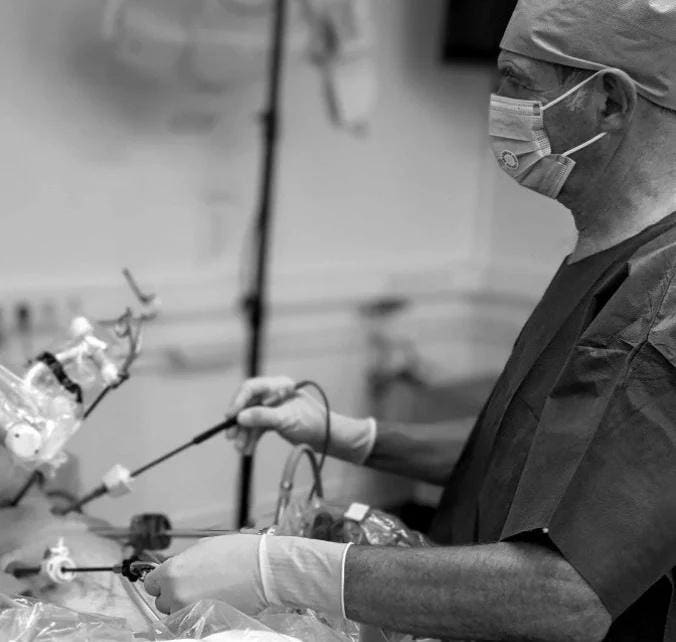On its website, Moon Surgical says plainly it “builds things that matter.”
For them, accessibility means reimagining the future of operating rooms. The company envisions a future in which the OR is controlled by empowered surgeons who confidently harness complete control, using technology adaptable to any situation they may encounter. Moon Surgical achieves this with its Maestro System, a piece of kit which uses robotic arms to hold instruments precisely in place during procedures.
The Maestro System was conceived and developed to assist surgeons with performing soft-tissue surgery, laparoscopy specifically. Moon Surgical has a demo video showing off how the device works.
“Our Maestro System is designed to empower surgeons during laparoscopies by providing an extra set of arms they can use to control two additional instruments,” said Moon Surgical chief executive, Anne Osdoit, in a recent interview with me conducted by email. “In doing so, the surgical staff that typically adjusts and holds the instruments for the surgeon to see and hold up tissue; can instead check on a patient that is recovering, or help prep the next patient for their procedure. This means the staff can better serve the patient, the surgeon is happier masterfully orchestrating their procedure, and the patient inherently benefits.”
Osdoit distilled her company’s mission down to building surgical robotics which aim to “improve the efficiency of healthcare delivery for every patient in every operating room.” Efficiency is fine, but the fact Osdoit and team are touting the Maestro System as literally another pair of hands is quintessential assistive technology, however unstated. The tech helps makes surgeons’ jobs more accessible because humans have only two hands and the Maestro System helps alleviate physical strain.
Osdoit said the Maestro System addresses four “major problems” facing surgeons today: access, complexity, cost, and time. In terms of access, Osdoit told me the technology ultimately helps patients receive higher-quality care. Surgeons generally prefer to work in hospitals who invest in the latest, cutting-edge equipment. Hospitals in more rural settings don’t have the necessary resources for that kind of gear; this means robotics surgery is typically limited to “premiere hospitals and academic institutions,” Osdoit said. Moon Surgical makes adopting this kind of technology much more feasible for every hospital and allows them to “keep talented surgeons in communities where they are needed.” Commensurate with access is cost, of which Osdoit told me is about $8 million over the span of 7 years. It would “break [the country’s] healthcare system” to put one of these platforms in every OR in America, according to Osdoit. Moon Surgical tries to break down this barrier by using a business model which allows doctors to spend less time in operating rooms and more time helping to care for their patients.
As to complexity and time, which also go hand-in-hand, Osdoit explained current systems are “massive, complex machines that are about the size of two Mini Coopers stacked on top of each other” that require high levels of training and dedicated rooms in hospitals. By contrast, Moon Surgical aims to disrupt this by designing the Maestro System with “simplicity at its core.” Osdoit and team have done “everything they could” to design the Maestro System in such a way that it doesn’t preclude or impede the practice of medicine. Moon Surgical is so aligned with that ideal that surgeons can use the tools they already know and love. Moreover, the company has worked closely with stakeholders—nursing, surgical assistants, service line managers, and administration—in a concerted effort to provide “value to all of them and designed a system that would make their lives easier.”
All this work coalesces into greater efficiency—timesaving.
“Time is critical. A hospital operating room costs about $40 a minute to run during the day,” Osdoit said. With the majority of laparoscopies being high volume, the rooms need to be turned over fast. They need to be swept, wiped, draped and ready for the next patient. Delays in this have massive repercussions because not only does it cost more, but it means you’ll probably have to cancel the last procedure of the day, sending a patient anxious about surgery all day home, or back to the ward only to repeat it again the next day. Our system is simple. It takes five minutes to turn over between cases. It takes no intense training program, or out of hospital courses. With Maestro, we aim to serve every operating room, big or small, fast or slow, by delivering a small, fast, and easy-to-use turnover system that surgeons, staff, and patients love.”
Osdoit also noted of the 20 million people who undergo soft tissue surgeries like laparoscopies, only 1.2 million, or 6%, use robotics during the procedures. Put another way, she added, there are approximately 30,000 operating rooms in the United States performing laparoscopies; only 4,000 of those leverage robotics. “There’s a massive population that needs improved surgical efficiency,” Osdoit said of the opportunity to make a positive impact. “We’re excited to work alongside other solutions to bring the technology to the rest of the 25,000 operating rooms.”
When asked about feedback on the Maestro System, Osdoit told me Moon Surgical hears from surgeons who are reporting less fatigue at the end of the day, also noting the company’s product have turned laparoscopies from tedious to joyful. She also pointed to comments made by one of Moon Surgical’s initial partners here in the United States in Dr. Ron Landmann. Dr. Landmann, chief of colon and rectal surgery and medical director of informatics at Baptist Health said in part the Maestro System “provides the control and dependability needed in minimally invasive surgery at a time when staffing shortages introduce workflow challenges and variability.”
As for Moon Surgical’s future, Osdoit reiterated what I wrote in the lede.
“Our mission is to create the operating room of the future,” she said. “[We want to create] a sustainable, efficient, digitized one, delivering the benefits of surgical robotics that surgeons love while preserving existing surgical workflow, technique, and instrumentation.”
Read the full article here










